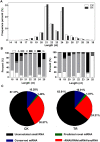Identification and characterization of microRNAs from tree peony (Paeonia ostii) and their response to copper stress
- PMID: 25658957
- PMCID: PMC4319853
- DOI: 10.1371/journal.pone.0117584
Identification and characterization of microRNAs from tree peony (Paeonia ostii) and their response to copper stress
Abstract
MicroRNAs (miRNAs) are a class of non-coding, small RNAs recognized as important regulators of gene expression. Although plant miRNAs have been extensively studied in model systems, less is known in other plants with limited genome sequence data, including Paeonia ostii. In this work, we used high-throughput sequencing to identify conserved and nonconserved miRNAs and other short RNAs in Paeonia ostii under control and copper stressed condition. 102 previously known plant miRNAs were identified and classified into 89 families according to their gene sequence identity. Some miRNAs were highly conserved in the plant kingdom suggesting that these miRNA play important and conserved roles. Combined our transcriptome sequencing data of Paeonia ostii under same conditions, 34 novel potential miRNAs were identified. The potential targets of the identified known and novel miRNAs were also predicted based on sequence homology search. Comparing the two libraries, it was observed that 12 conserved miRNAs and 18 novel miRNAs showed significantly changes in response to copper stress. Some of the new identified potential miRNAs might be involved in Paeonia ostii-specific regulating mechanisms under copper stress. These results provide a framework for further analysis of miRNAs and their role in regulating Paeonia ostii response to copper stress.
Conflict of interest statement
Figures





Similar articles
-
De novo transcriptome sequencing and discovery of genes related to copper tolerance in Paeonia ostii.Gene. 2016 Jan 15;576(1 Pt 1):126-35. doi: 10.1016/j.gene.2015.09.077. Gene. 2016. PMID: 26435192
-
Identification of microRNAs and long non-coding RNAs involved in fatty acid biosynthesis in tree peony seeds.Gene. 2018 Aug 5;666:72-82. doi: 10.1016/j.gene.2018.05.011. Epub 2018 May 5. Gene. 2018. PMID: 29738839
-
High-throughput deep sequencing shows that microRNAs play important roles in switchgrass responses to drought and salinity stress.Plant Biotechnol J. 2014 Apr;12(3):354-66. doi: 10.1111/pbi.12142. Epub 2013 Nov 28. Plant Biotechnol J. 2014. PMID: 24283289
-
A potential role of microRNAs in plant response to metal toxicity.Metallomics. 2013 Sep;5(9):1184-90. doi: 10.1039/c3mt00022b. Metallomics. 2013. PMID: 23579282 Review.
-
Keep calm and carry on: miRNA biogenesis under stress.Plant J. 2019 Sep;99(5):832-843. doi: 10.1111/tpj.14369. Epub 2019 May 23. Plant J. 2019. PMID: 31025462 Review.
Cited by
-
Characterization and bioinformatics analysis of ptc-miR396g-5p in response to drought stress of Paeonia ostii.Noncoding RNA Res. 2022 Jun 20;7(3):150-158. doi: 10.1016/j.ncrna.2022.06.002. eCollection 2022 Sep. Noncoding RNA Res. 2022. PMID: 35799773 Free PMC article.
-
Identification of differentially expressed miRNAs and their target genes in response to brassinolide treatment on flowering of tree peony (Paeonia ostii).Plant Signal Behav. 2022 Dec 31;17(1):2056364. doi: 10.1080/15592324.2022.2056364. Plant Signal Behav. 2022. PMID: 35343364 Free PMC article.
-
TaMIR1139: a wheat miRNA responsive to Pi-starvation, acts a critical mediator in modulating plant tolerance to Pi deprivation.Plant Cell Rep. 2018 Sep;37(9):1293-1309. doi: 10.1007/s00299-018-2313-6. Epub 2018 Jun 9. Plant Cell Rep. 2018. PMID: 29947952
-
Identification of Submergence-Responsive MicroRNAs and Their Targets Reveals Complex MiRNA-Mediated Regulatory Networks in Lotus (Nelumbo nucifera Gaertn).Front Plant Sci. 2017 Jan 18;8:6. doi: 10.3389/fpls.2017.00006. eCollection 2017. Front Plant Sci. 2017. PMID: 28149304 Free PMC article.
-
Function of floral fragrance-related microRNAs and their targets in Hedychium coronarium.BMC Genomics. 2025 Apr 30;26(1):430. doi: 10.1186/s12864-025-11583-0. BMC Genomics. 2025. PMID: 40307688 Free PMC article.
References
-
- Cobbett C, Goldsbrough P (2002) Phytochelatins and metallothioneins: roles in heavy metal detoxification and homeostasis. Annu Rev Plant Biology 53: 159–182. - PubMed
-
- Jin Q, Zhu K, Xie Y, Shen W (2013) Heme oxygenase-1 is involved in ascorbic acid-induced alleviation of cadmium toxicity in root tissues of Medicago sativa. Plant Soil 366: 605–616.
-
- Yadav S (2010) Heavy metals toxicity in plants: an overview on the role of glutathione and phytochelatins in heavy metal stress tolerance of plants. S Afr J Bot 76: 167–179.
-
- Clemens S (2001) Molecular mechanisms of plant metal tolerance and homeostasis. Planta 212: 475–486. - PubMed
Publication types
MeSH terms
Substances
LinkOut - more resources
Full Text Sources
Other Literature Sources

